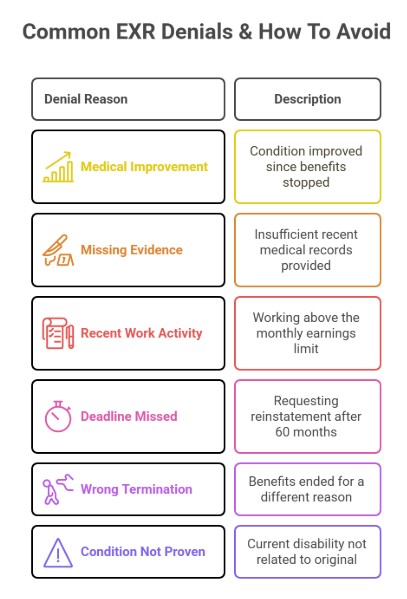
When to Request Expedited Reinstatement (EXR) in NC SSDI: Key Timing Considerations for North Carolina Recipients
Originally published: November 2025 | Reviewed by Perry Morrison

Going back to work after getting Social Security Disability Insurance benefits can feel like a big step. But what if your health problems come back, and working just isn’t possible anymore?
Plenty of North Carolina residents don’t realize they have options besides starting over with a brand new disability claim.
If you lost SSDI benefits because of work activity, you can ask for expedited reinstatement within five years of your benefits ending. This way, you skip the long wait for a new application.
This process—Expedited Reinstatement, or EXR—gives you a faster route back to benefits. You might even receive temporary payments while the SSA reviews your case.
Common EXR Denials & How To Avoid Them (Practical Fixes)
Knowing when and how to use EXR can save you a lot of time and stress. The rules about your work history, FICA payments, and timing all decide if you qualify for this safety net.
Key Takeaways
- EXR lets former SSDI recipients restart benefits without a new application if they request it within five years of losing benefits due to work.
- Applicants can get up to six months of temporary benefits while SSA reviews their request.
- EXR is usually faster than filing a new claim and provides immediate provisional payments.
What Is Expedited Reinstatement (EXR)

EXR is a built-in Social Security rule that allows prior SSDI (and SSI) beneficiaries whose benefits ended due to earnings to request immediate reconsideration and temporary payments — avoiding a full new application if certain conditions are met.
Use Form SSA-371 (Title II) or SSA-372 (Title XVI) to start the process.
One-Line Legal Hook (CFR/POMS References) — EXR Authority
Expedited Reinstatement is governed by 20 CFR 404.1592c and Social Security POMS DI 13050.001. These rules make EXR an official work incentive program.
This legal setup creates a safety net for people who try to work again but can’t keep going because of their medical condition.
Key EXR Requirements:
- Request within 5 years of benefits ending
- Benefits ended due to work or earnings
- The same or related disabling condition now keeps you from working
- Had SSDI, CDB, or DWB benefits before
EXR provides provisional benefits for up to 6 months while SSA conducts a medical review. This temporary payment helps you avoid financial trouble during the wait.
You skip the usual long application. Instead of starting over, you just file Form SSA-371.
Morrison Law Firm helps North Carolina residents restart SSDI benefits when work becomes impossible again. Get clear next steps and quick guidance — Contact us.
If you’re ready to get started, call us now!
When Should Someone In North Carolina Request An EXR? (Decision Rules)

If you’re an SSDI recipient in North Carolina and your disability returns after benefits ended because you worked, it’s time to look at EXR. The right timing depends on a few key triggers.
Here are three situations where you should request EXR right away in North Carolina:
- Your work earnings drop below SGA levels – If your monthly earnings fall below the current substantial gainful activity threshold, you can apply for EXR the same month you stop SGA. This rule started in April 2017.
- Your medical condition gets worse – If your original disability comes back or gets worse and you can’t work, you should ask for expedited reinstatement without having to start over.
- You lose your job because of your disability – If you have to quit work because your disability stops you from doing your job, request EXR right away. Provisional benefits can start the month after your request if SGA ends that month.
EXR Vs Filing A New SSDI Claim — When EXR Is Better

Expedited reinstatement gives you faster provisional benefits and skips the long application process.
With a new claim, you’re back to square one—new medical evidence, more waiting, and more frustration.
Quick Compare Table (EXR Vs New Claim)
| Factor | Expedited Reinstatement (EXR) | New SSDI Claim |
| Processing Time | Up to 6 months of provisional benefits immediately | 3-6 months minimum wait |
| Medical Review | Uses previous disability determination | Requires all new medical evidence |
| Work Incentives | New trial work period after approval | Standard trial work period rules |
| Best For | Same or related disability condition | Completely different disability |
| Time Limit | Must file within 60 months | No time limit |
| Medicare | Continues previous coverage | New Medicare waiting period |
| Success Rate | Higher for related conditions | Depends on new medical evidence |
EXR usually makes the most sense if your disability is the same or related to what you had before. You can get provisional payments while you wait for the final answer.
Step-By-Step: How To Request EXR In North Carolina (Practical Filing Checklist)

Filing for expedited reinstatement in North Carolina means you’ll need certain documents and good timing.
You’ll gather medical records, complete forms, and submit your request through the appropriate Social Security channels.
Pre-Filing Checklist
Before you start, make sure you meet the basics. Your benefits must have ended within the last five years because you worked or earned too much.
Here’s what you’ll want to collect:
- Medical records from the past 12 months
- Work history showing when you stopped substantial gainful activity
- Letters about your previous disability determination
- Photo ID and your Social Security card
- Bank statements for direct deposit
Get in touch with your doctor and ask for updated records. Sometimes this takes a week or two, so don’t wait too long.
Double-check that your work earnings actually stopped before you file. The new rules let you apply for EXR in the same month you stop working.
Timing tip: You can get provisional benefits starting the month after your request if you stopped working that same month.
EXR Filing Checklist
For the actual filing, you’ll need Form SSA-371. Take your time and double-check every answer.
Ways to file in North Carolina:
| Method | Time Required | Best For |
| In-person at the field office | 1-2 hours | Complex cases |
| Phone appointment | 30-45 minutes | Simple requests |
| Online portal | 15-30 minutes | Tech-savvy applicants |
Bring all your documents to your local Social Security office. North Carolina’s Disability Determination Services will check your medical eligibility.
Filing steps:
- Submit Form SSA-371 with your medical evidence
- Request provisional benefits during the review
- Give updated contact info
- Set up follow-up appointments if needed
The reinstatement process usually takes around 3-5 months. Provisional benefits can start right away and last up to six months while Social Security reviews your case.
| Item | Why it matters | Example proof |
| SSA award letter/termination notice | Verifies prior entitlement and termination date | SSA award letter PDF |
| Medical records since the benefit end | Shows current inability to work | Hospital notes, doctor statements |
| Recent pay stubs/employer letter | Shows you are not at SGA now | Last three pay stubs |
| SSA-371 / SSA-372 completed | Formal request form | Signed form copy |
| Contact info for the local SSA office | Where to submit & follow up | Local office phone/address |
What Provisional Benefits Can You Get While SSA Reviews EXR?
If you request expedited reinstatement, you might get up to six months of provisional benefits while Social Security reviews your case.
These temporary payments cover both cash and medical coverage, helping you get by while you wait for a decision.
How Provisional Payments Affect Overpayments And Appeals
Provisional benefits are temporary payments that act as a safety net during EXR review. The beneficiary gets these payments for up to six months while SSA checks eligibility.
Key provisional benefit types include:
- Monthly cash payments
- Medicare coverage continuation
- Medicaid coverage (when applicable)
If SSA approves the EXR request, provisional payments become regular benefits. If they deny the request, the beneficiary must repay all provisional benefits received.
Medicare coverage during the provisional benefit period remains the same as when benefits initially ended. This includes Medicare Part D prescription drug coverage and premiums.
The provisional benefit amount matches what the person received before termination. SSA doesn’t require a pile of medical paperwork to start these payments, so people usually get them pretty quickly after filing the EXR request.
Unsure whether to file EXR or start a new SSDI claim? Talk with a disability attorney at Morrison Law Firm to avoid delays and confusion. Schedule an appointment today.
If you’re ready to get started, call us now!
Common EXR Denials & How To Avoid Them (Practical Fixes)

Most EXR denials occur when the Social Security Administration finds medical improvement or determines that the person can return to work.
Knowing these common pitfalls helps folks prepare stronger requests and avoid costly delays.
Top 6 Denial Reasons
The medical improvement review standard applies to EXR requests, just as it does for continuing disability reviews. Here are the main reasons applications get denied:
- Medical improvement found – Recent records show the condition improved compared to when benefits stopped.
- Missing medical evidence – Not enough current doctor visits, tests, or treatment records from the past year.
- Work activity too recent – Filing EXR while still working above $1,550 monthly.
- Five-year deadline missed – Requesting reinstatement more than 60 months after benefits ended because of work.
- Wrong termination reason – Benefits ended for reasons other than work earnings, like a continuing disability review.
- Same medical condition not proven – Can’t show the current disability is the same or related to the original condition.
Practical fixes include:
Get recent medical exams before filing. Stop all work activity in the month you request EXR.
Keep detailed records of when benefits ended and why. Ask your doctor to document how your condition limits daily activities and work ability.
Timeline & Expectations After Filing EXR
The EXR process usually takes several months, and applicants might get provisional benefits while Social Security reviews their case.
Knowing the timeline helps set realistic expectations for when benefits might resume.
Typical EXR Timeline
Month 1-2: Initial Processing
After you file Form SSA-371, Social Security starts reviewing the request. They first check basic requirements, such as the five-year filing deadline.
Month 2-3: Provisional Benefits Decision
Social Security may approve up to 6 months of provisional benefits while the case is under review. These temporary payments help bridge the gap during processing.
Months 3-6: Medical Review
Examiners review medical evidence to determine whether the disability continues to prevent substantial work. They might ask for more records or schedule exams.
Month 6-8: Final Decision
Social Security issues a final determination on permanent reinstatement. If approved, benefits continue beyond the provisional period. If denied, you have to repay provisional benefits unless you qualify for a waiver of overpayment recovery.
The timeline for expedited reinstatement can vary depending on the case’s complexity and the speed of medical evidence.
When To Call A Lawyer Or Get Formal Representation
Most SSDI expedited reinstatement cases move forward without legal help. But when things get complicated, professional guidance can make a real difference. If you are denied, your best option is to retain a lawyer.
Contingency fee arrangements make legal representation accessible when appeals or complications arise.
Quick Cost/Benefit Checklist For Legal Help
When Legal Help Makes Sense:
- EXR request gets denied at first.
- Medical evidence feels scattered or tough to organize.
- Questions pop up about your past work activity.
- You need to start the appeals process.
Cost Structure:
Social Security disability lawyers usually work on a contingency fee basis. They get 25% of your back benefits or $7,200, whichever is less.
For most cases, you won’t pay anything up front.
What Lawyers Handle:
- Filing expedited reinstatement paperwork the right way
- Collecting medical records and other documents
- Talking with the Social Security Administration
- Appealing if your EXR request gets denied
- Helping protect your provisional benefits while your case is under review
Red Flags Requiring Legal Help:
- SSA asks about substantial gainful activity
- You have more than one medical condition in play
- Your benefits were previously terminated, and you disagreed with it
- You’re eligible for expedited reinstatement, but still can’t get approved
Ready to restart your SSDI benefits quickly? We gather records, file the EXR request, and communicate with Social Security on your behalf. Take the next step with Morrison Law Firm — Contact us.
If you’re ready to get started, call us now!
Frequently Asked Questions
What is Expedited Reinstatement (EXR)?
Expedited Reinstatement (EXR) allows someone whose SSDI benefits stopped because they returned to work to restart benefits without filing a new application if they can no longer work due to the same or a related disability. The request is made within 60 months.
When should I request EXR?
Request EXR as soon as you stop working or your income drops below Substantial Gainful Activity (SGA) levels, and the disability preventing work is the same or closely related to your previous SSDI claim.
What forms do I need to file for EXR in North Carolina?
You need to submit Form SSA-371 (SSDI) or SSA-372 (SSI) to your local Social Security office. A disability attorney can submit it for you.
Can I get benefits while Social Security decides on EXR?
Yes. If you qualify, Social Security may grant provisional benefits for up to six months, including monthly payments and access to Medicare/Medicaid.
What are the requirements for EXR approval?
You must:
- Have previously received SSDI/SSI.
- Have had benefits end because of work earnings.
- Be unable to work again because of the same or related disability.
- Apply within five years (60 months) of termination.
Is EXR faster than filing a new SSDI application?
Yes. EXR uses your previous disability approval, avoiding the need to start a new application from scratch. It focuses on whether your disability again prevents you from working.
Do I need an attorney for EXR?
You are not required to have one, but an attorney can track deadlines, submit evidence, and ensure Social Security reviews the EXR under the correct rules, reducing delays and denials.

